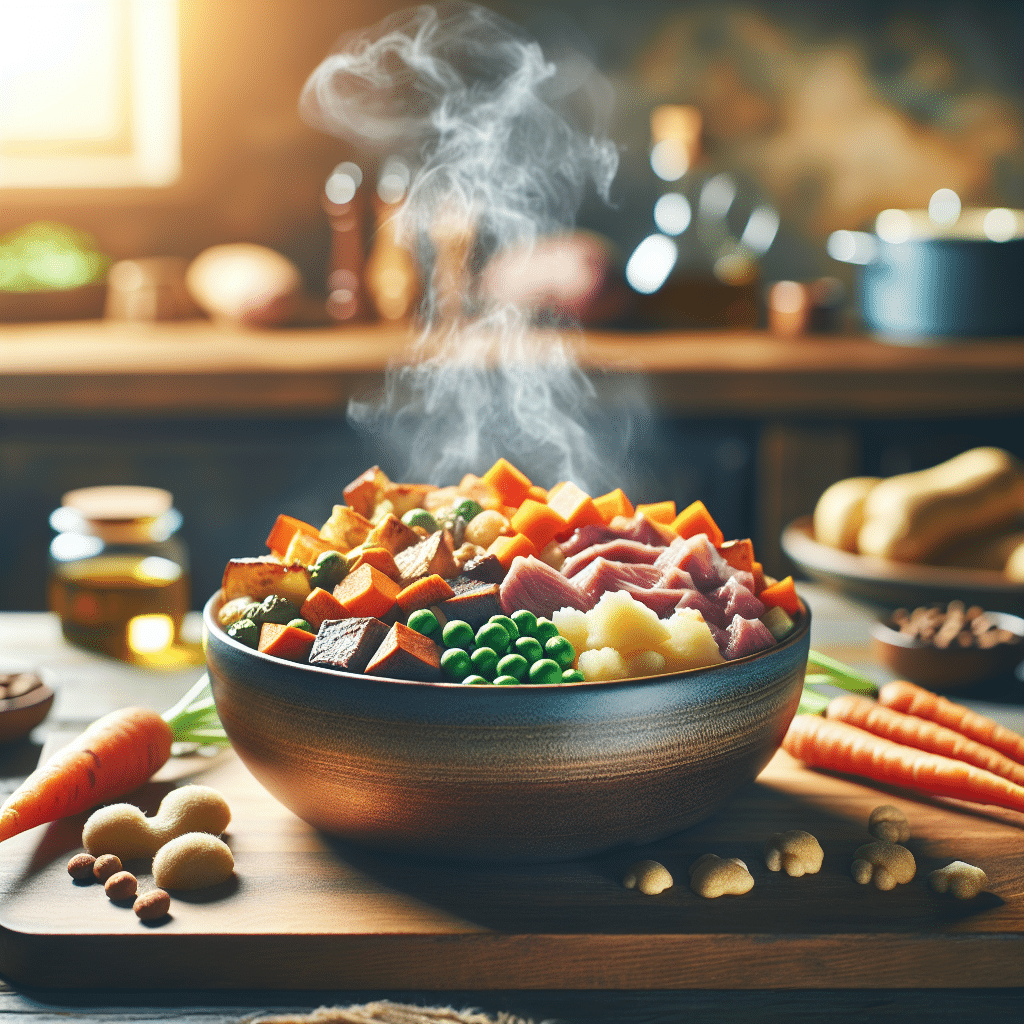Understanding Dog Food Allergies
Dogs can suffer from food allergies just like humans, and these allergies can manifest in various ways, including skin irritations, gastrointestinal upset, and itching. Common allergens in commercial dog foods often include beef, chicken, dairy, wheat, and soy. Identifying and eliminating these allergens is crucial for maintaining your dog’s health. Homemade dog food allows you to control the ingredients and avoid fillers and potential allergens that might be present in commercial brands.
Key Ingredients for Homemade Dog Food
1. Proteins
- Single-Sourced Proteins: If your dog is allergic to common proteins, consider using lamb, fish, or turkey. Fish, particularly, is rich in omega-3 fatty acids, which can help reduce inflammation and improve skin condition.
- Eggs: These are a fantastic protein source for dogs without an egg allergy, providing essential amino acids and nutrients.
2. Carbohydrates
- Brown Rice: A great source of fiber and energy, brown rice is gentle on the stomach.
- Sweet Potatoes: Packed with beta-carotene and dietary fiber, they are excellent for digestion and a great alternative to common grains.
- Quinoa: Gluten-free and rich in nutrients, quinoa is a superb carbohydrate alternative.
3. Vegetables
- Carrots: Rich in vitamins and low in calories, they are great for skin health.
- Spinach: High in iron, vitamins, and antioxidants, spinach promotes overall health.
- Pumpkin: A good source of fiber and beneficial for digestive health.
4. Fats
- Flaxseed Oil: An excellent source of omega-3 fatty acids, beneficial for skin and coat.
- Coconut Oil: Supports immune function and enhances skin health while providing a good energy source.
Homemade Dog Food Recipes for Allergies
Recipe 1: Turkey and Sweet Potato Stew
Ingredients:
- 1 lb ground turkey
- 1 medium sweet potato, diced
- 1 cup carrots, chopped
- 1/2 cup peas, frozen or fresh
- 2 cups low-sodium chicken broth (homemade or low-salt)
- 1 tablespoon coconut oil
Instructions:
- In a large pot, heat coconut oil over medium heat.
- Add ground turkey and cook until browned.
- Stir in sweet potatoes, carrots, and peas.
- Pour in the chicken broth and bring to a boil.
- Reduce heat and let simmer for 20-30 minutes until vegetables are tender.
- Let cool before serving.
Recipe 2: Fish and Quinoa Delight
Ingredients:
- 1 lb salmon or white fish, skin removed
- 1 cup quinoa, rinsed
- 2 cups water
- 1/2 cup spinach, chopped
- 1 tablespoon flaxseed oil
Instructions:
- In a saucepan, combine quinoa and water, bringing to a boil. Reduce heat to low and simmer until quinoa is cooked and water is absorbed (about 15 minutes).
- Meanwhile, steam the fish until cooked through, then flake into pieces.
- Mix the quinoa, flaked fish, chopped spinach, and flaxseed oil in a large bowl.
- Allow to cool before serving.
Recipe 3: Lamb and Vegetable Mix
Ingredients:
- 1 lb ground lamb
- 1 cup brown rice
- 1 carrot, shredded
- 1/2 cup zucchini, shredded
- 1 tablespoon olive oil
- 2 cups water
Instructions:
- In a pot, combine brown rice and water, bringing to a boil. Reduce heat to low and simmer until cooked.
- In a separate skillet, heat olive oil, add ground lamb, and cook until browned.
- Mix in shredded carrot and zucchini and cook until vegetables are tender.
- Combine cooked rice with lamb mixture and stir well.
- Let cool before serving to your dog.
Recipe 4: Chicken-Free Veggie Bowl
Ingredients:
- 1 cup lentils, rinsed
- 2 medium sweet potatoes, peeled and cubed
- 1 cup green beans, chopped
- 1 tablespoon coconut oil
- 2 cups vegetable broth (low-sodium)
Instructions:
- In a pot, add lentils and vegetable broth, bring to a boil, then reduce to a simmer.
- In another pot, steam sweet potatoes and green beans until soft.
- Add the vegetables to the lentils and stir in coconut oil.
- Let the mix cool before serving.
Nutritional Considerations
When preparing homemade dog food, it’s crucial to ensure that recipes meet your dog’s nutritional needs. Consult your veterinarian or a pet nutritionist to balance protein, fats, carbohydrates, vitamins, and minerals properly. Also, consider adding supplements as needed, especially if you’re using alternative protein sources.
Safety Tips
- Ingredient Checks: Always verify that ingredients are safe for canine consumption. Foods like garlic, onions, and chocolate are toxic to dogs.
- Proper Storage: Store homemade dog food in airtight containers in the refrigerator for up to five days. For longer storage, consider freezing portions for convenience.
- Gradual Transition: When introducing a homemade diet, transition your dog gradually to avoid gastrointestinal upset. Mix in small amounts of homemade food with the existing diet and gradually increase the proportion.
Monitoring Allergies
After switching to a homemade diet, observe your dog for improvements in their allergy symptoms. Keep track of any recurrences of allergic reactions and adjust ingredients accordingly. It may be helpful to maintain a log of foods consumed and reactions noted.
Final Thoughts
Creating homemade dog food recipes tailored for allergies is a positive way to enhance your dog’s health and well-being. By carefully selecting ingredients and crafting balanced meals, you empower yourself to provide nutrition your dog will love while alleviating the discomfort caused by allergies. Always prioritize your dog’s health and seek professional advice when making significant dietary changes.
